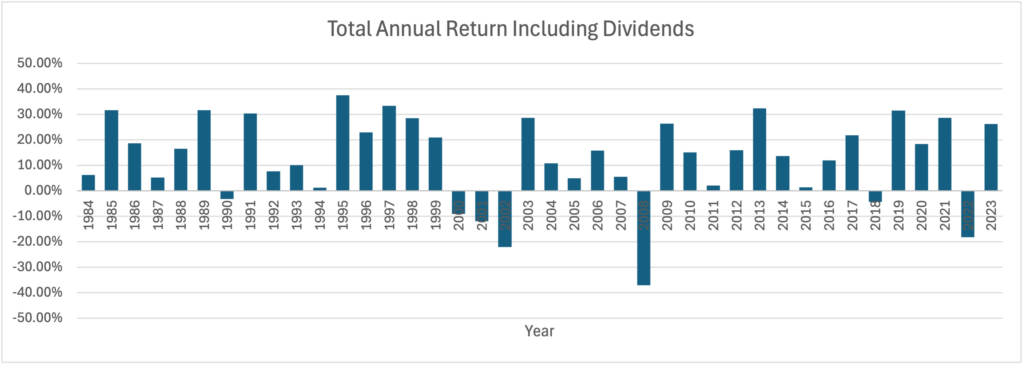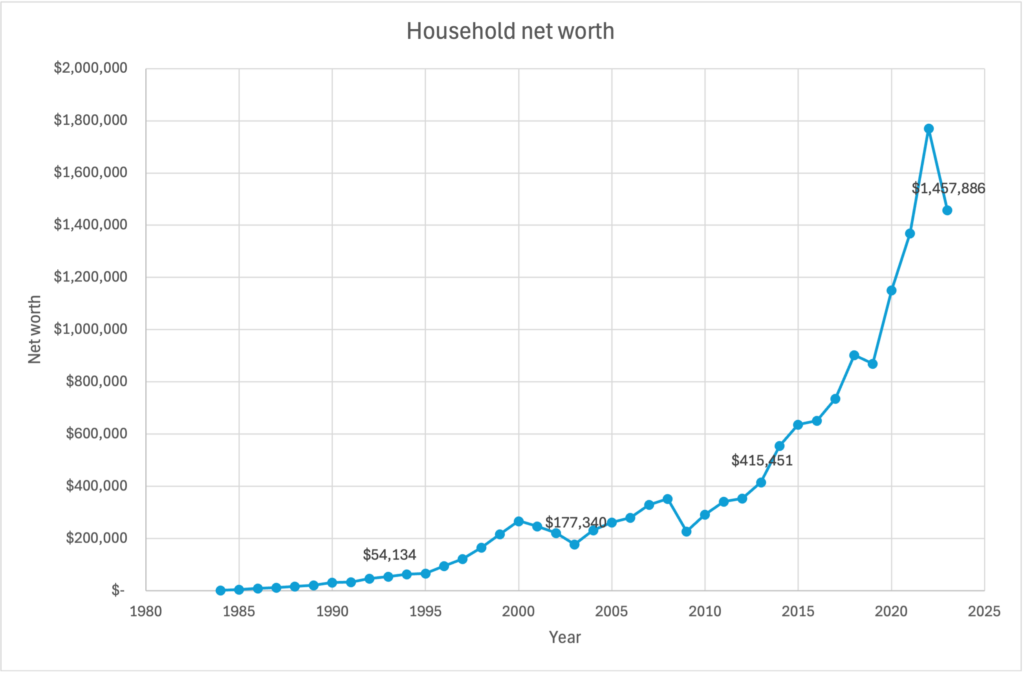How wealthy can an average American household become without extraordinary talent, luck or privilege? I was curious, so I explored the numbers.
Understanding median income
The median household income represents the middle point in American earnings—half of all households earn more, and half earn less. Today, the median household income is just over $80,000. In 1984, it was approximately $22,000. You can see the numbers in the chart below.
Growing wealth over a 40-year working period
Let’s assume a household earns the median income every year from 1984 to 2023, a typical 40-year working period (ages 25 to 65). If this household saves 10% of its income annually and invests it entirely in the S&P 500 index of American stocks, how much wealth would they accumulate until 2024?
Returns of the S&P500 index for each year since 1984 are shown below. Most years had positive returns, a few negative, sometimes even large negative returns such as the 2008 financial crisis. Despite market fluctuations, the household remains invested.

The Result: A Millionaire Household
Starting from nothing in 1983, this median-income household would amass over $1.4 million by 2023. The following figure shows how this household’s net worth grows over time. The net worth in every tenth year (1993, 2003, 2013, 2023) is printed on the chart.

Is This Achievable in Real Life?
It is achievable. I have shared stories of low-income people who became rich, even people who earned far less than median income. The two essential components are i. frugality leading to savings and ii. investing leading to compounding. However, a few real-world factors must be considered:
- Taxes – Taxes can reduce compounding, but this is not a deal-breaker. Retirement accounts allow investments to grow tax-free. Even outside retirement accounts, long-term index investing benefits from lower tax rates.
- Investment costs – The expense ratios of low-cost index funds is less than 0.05%, which is negligible. Examples include the ETFs IVV, VOO and SPLG.
- Homeownership & Investment Choices – This model assumes all savings go into stocks, but a family may want to buy a home at some point. While home values generally appreciate slower than stocks, real estate allows for leveraged gains through mortgages. The ownership of a primary residence also comes with tax-breaks such as mortgage interest credit, certain deductible expenses, and a home sale tax exclusion. Many Americans achieve wealth through homeownership, though poorly timed purchases and overpaying can lead to financial hardship.
What holds people back
The biggest obstacle to wealth accumulation is insufficient savings. Data since 2000 (chart below) shows that the average personal savings rate (excluding the post-COVID period) has hovered around 5%—well below the 10% necessary to reach millionaire status on a median income. Another reason why people may struggle to become wealthy is by not investing or investing poorly.
The Reality of the American Dream
The American Dream suggests that anyone can achieve success, but many feel it is slipping away. Income disparity has widened significantly. Research shows that while U.S. income grew by 61% from 1980 to 2014, most gains benefited the wealthiest. The bottom half saw just a 1% increase, while the top 1% enjoyed a staggering 205% income growth.
Many Americans feel trapped in a system that favors the wealthy. While policy changes are necessary to address systemic inequality, individuals can still build wealth through disciplined saving and investing. The journey is long, requiring decades of commitment, but the path exists and is well-documented.
Thanks for reading. If you like my writing, please share my blog and consider following me on Twitter.
